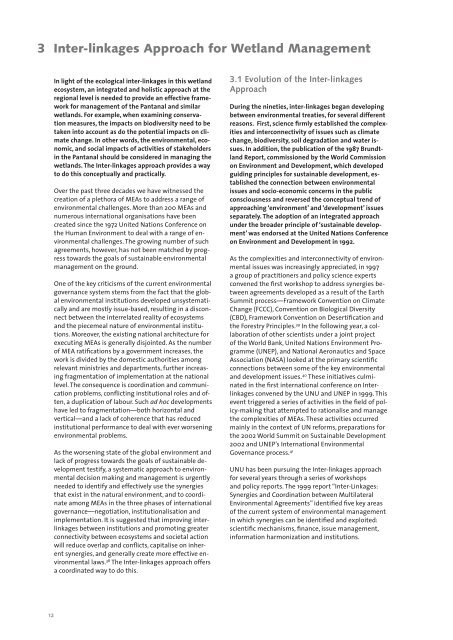Inter-linkages Approach for Wetland Management - UNU-IAS ...
Inter-linkages Approach for Wetland Management - UNU-IAS ...
Inter-linkages Approach for Wetland Management - UNU-IAS ...
You also want an ePaper? Increase the reach of your titles
YUMPU automatically turns print PDFs into web optimized ePapers that Google loves.
3 <strong>Inter</strong>-<strong>linkages</strong> <strong>Approach</strong> <strong>for</strong> <strong>Wetland</strong> <strong>Management</strong><br />
In light of the ecological inter-<strong>linkages</strong> in this wetland<br />
ecosystem, an integrated and holistic approach at the<br />
regional level is needed to provide an effective framework<br />
<strong>for</strong> management of the Pantanal and similar<br />
wetlands. For example, when examining conservation<br />
measures, the impacts on biodiversity need to be<br />
taken into account as do the potential impacts on climate<br />
change. In other words, the environmental, economic,<br />
and social impacts of activities of stakeholders<br />
in the Pantanal should be considered in managing the<br />
wetlands. The <strong>Inter</strong>-<strong>linkages</strong> approach provides a way<br />
to do this conceptually and practically.<br />
Over the past three decades we have witnessed the<br />
creation of a plethora of MEAs to address a range of<br />
environmental challenges. More than 200 MEAs and<br />
numerous international organisations have been<br />
created since the 1972 United Nations Conference on<br />
the Human Environment to deal with a range of environmental<br />
challenges. The growing number of such<br />
agreements, however, has not been matched by progress<br />
towards the goals of sustainable environmental<br />
management on the ground.<br />
One of the key criticisms of the current environmental<br />
governance system stems from the fact that the global<br />
environmental institutions developed unsystematically<br />
and are mostly issue-based, resulting in a disconnect<br />
between the interrelated reality of ecosystems<br />
and the piecemeal nature of environmental institutions.<br />
Moreover, the existing national architecture <strong>for</strong><br />
executing MEAs is generally disjointed. As the number<br />
of MEA ratifications by a government increases, the<br />
work is divided by the domestic authorities among<br />
relevant ministries and departments, further increasing<br />
fragmentation of implementation at the national<br />
level. The consequence is coordination and communication<br />
problems, conflicting institutional roles and often,<br />
a duplication of labour. Such ad hoc developments<br />
have led to fragmentation—both horizontal and<br />
vertical—and a lack of coherence that has reduced<br />
institutional per<strong>for</strong>mance to deal with ever worsening<br />
environmental problems.<br />
As the worsening state of the global environment and<br />
lack of progress towards the goals of sustainable development<br />
testify, a systematic approach to environmental<br />
decision making and management is urgently<br />
needed to identify and effectively use the synergies<br />
that exist in the natural environment, and to coordinate<br />
among MEAs in the three phases of international<br />
governance—negotiation, institutionalisation and<br />
implementation. It is suggested that improving inter<strong>linkages</strong><br />
between institutions and promoting greater<br />
connectivity between ecosystems and societal action<br />
will reduce overlap and conflicts, capitalise on inherent<br />
synergies, and generally create more effective environmental<br />
laws. 38 The <strong>Inter</strong>-<strong>linkages</strong> approach offers<br />
a coordinated way to do this.<br />
3.1 Evolution of the <strong>Inter</strong>-<strong>linkages</strong><br />
<strong>Approach</strong><br />
During the nineties, inter-<strong>linkages</strong> began developing<br />
between environmental treaties, <strong>for</strong> several different<br />
reasons. First, science firmly established the complexities<br />
and interconnectivity of issues such as climate<br />
change, biodiversity, soil degradation and water issues.<br />
In addition, the publication of the 1987 Brundtland<br />
Report, commissioned by the World Commission<br />
on Environment and Development, which developed<br />
guiding principles <strong>for</strong> sustainable development, established<br />
the connection between environmental<br />
issues and socio-economic concerns in the public<br />
consciousness and reversed the conceptual trend of<br />
approaching ‘environment’ and ‘development’ issues<br />
separately. The adoption of an integrated approach<br />
under the broader principle of ‘sustainable development’<br />
was endorsed at the United Nations Conference<br />
on Environment and Development in 1992.<br />
As the complexities and interconnectivity of environmental<br />
issues was increasingly appreciated, in 1997<br />
a group of practitioners and policy science experts<br />
convened the first workshop to address synergies between<br />
agreements developed as a result of the Earth<br />
Summit process—Framework Convention on Climate<br />
Change (FCCC), Convention on Biological Diversity<br />
(CBD), Framework Convention on Desertification and<br />
the Forestry Principles. 39 In the following year, a collaboration<br />
of other scientists under a joint project<br />
of the World Bank, United Nations Environment Programme<br />
(UNEP), and National Aeronautics and Space<br />
Association (NASA) looked at the primary scientific<br />
connections between some of the key environmental<br />
and development issues. 40 These initiatives culminated<br />
in the first international conference on <strong>Inter</strong><strong>linkages</strong><br />
convened by the <strong>UNU</strong> and UNEP in 1999. This<br />
event triggered a series of activities in the field of policy-making<br />
that attempted to rationalise and manage<br />
the complexities of MEAs. These activities occurred<br />
mainly in the context of UN re<strong>for</strong>ms, preparations <strong>for</strong><br />
the 2002 World Summit on Sustainable Development<br />
2002 and UNEP’s <strong>Inter</strong>national Environmental<br />
Governance process. 41<br />
<strong>UNU</strong> has been pursuing the <strong>Inter</strong>-<strong>linkages</strong> approach<br />
<strong>for</strong> several years through a series of workshops<br />
and policy reports. The 1999 report “<strong>Inter</strong>-Linkages:<br />
Synergies and Coordination between Multilateral<br />
Environmental Agreements” identified five key areas<br />
of the current system of environmental management<br />
in which synergies can be identified and exploited:<br />
scientific mechanisms, finance, issue management,<br />
in<strong>for</strong>mation harmonization and institutions.<br />
12

















